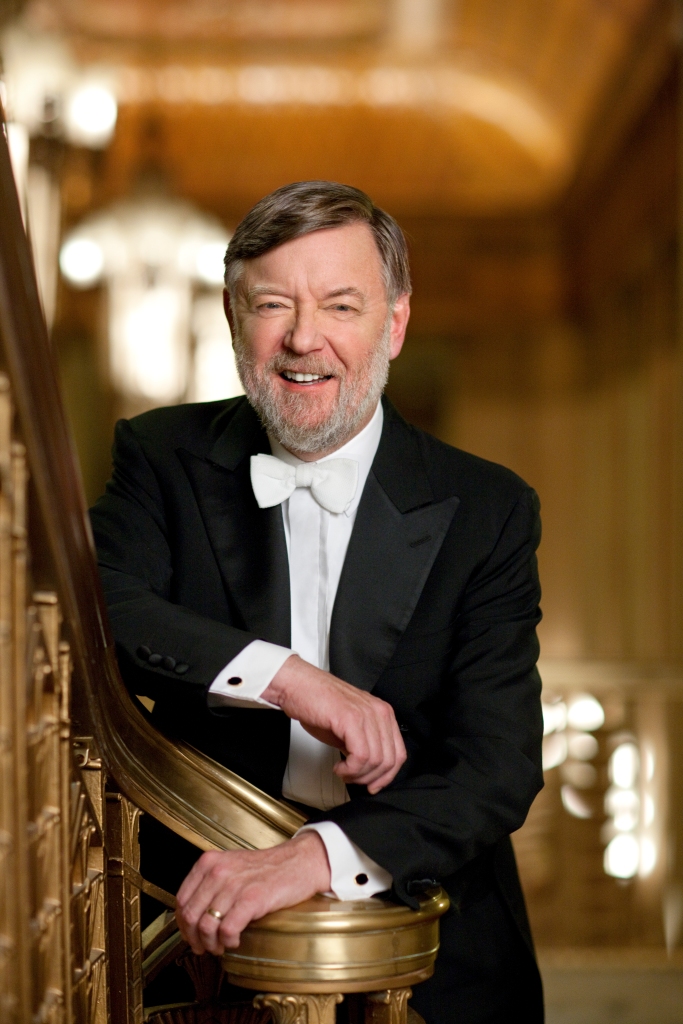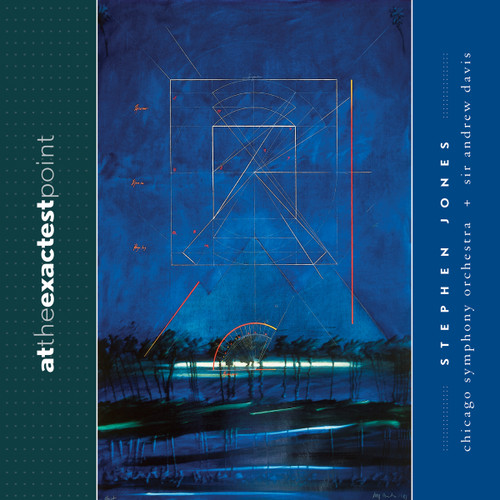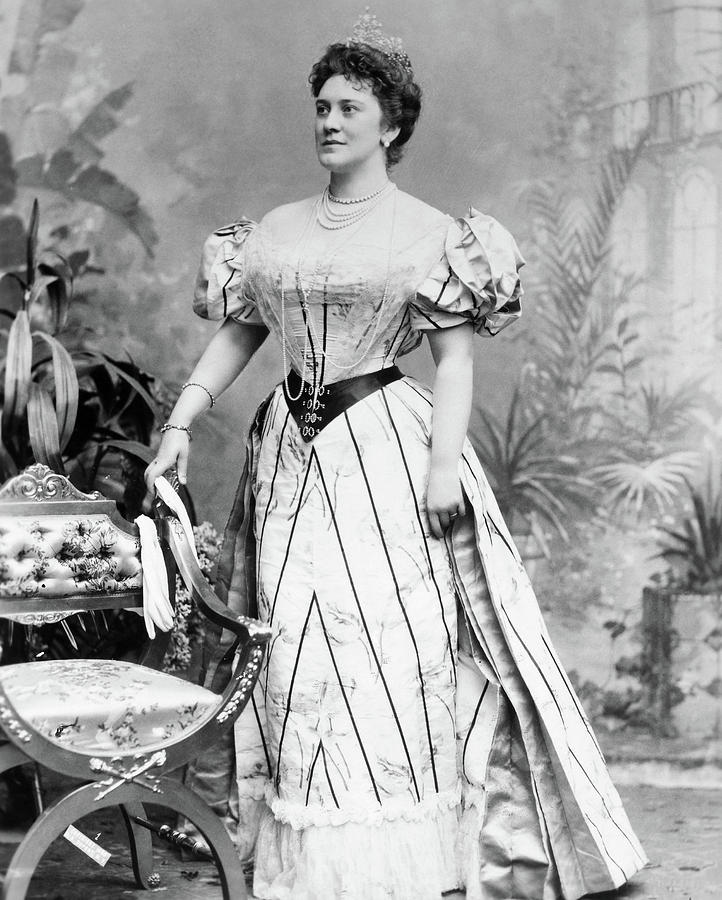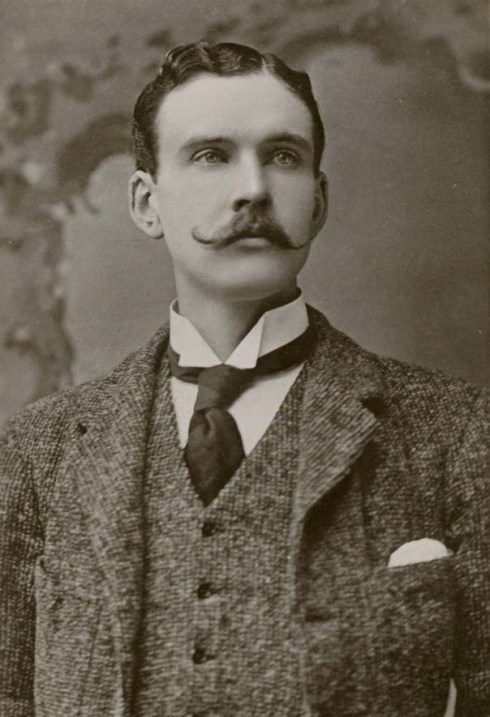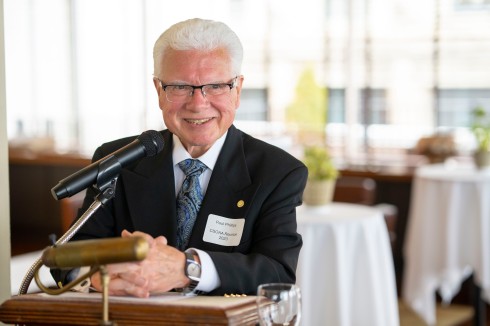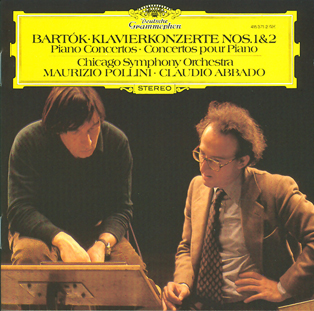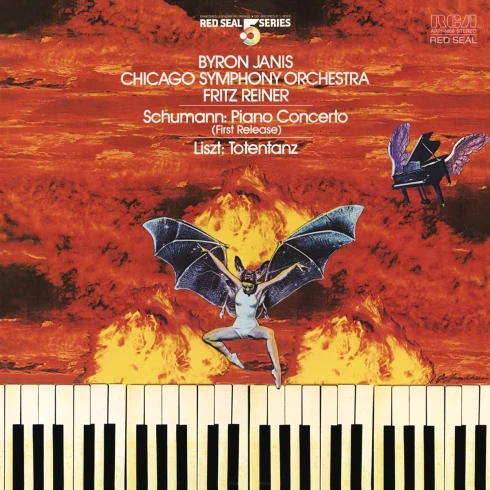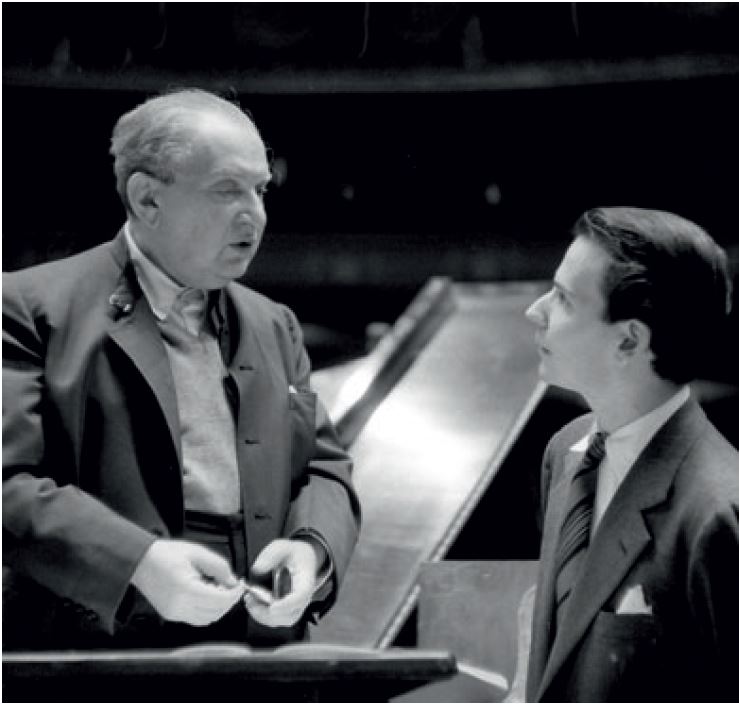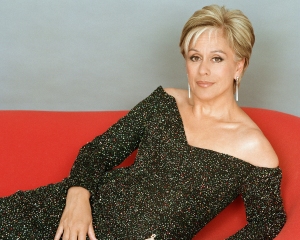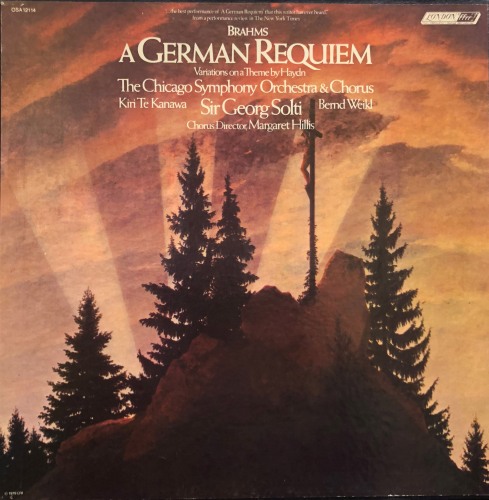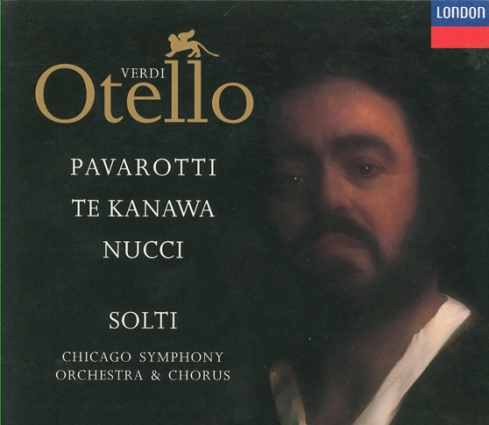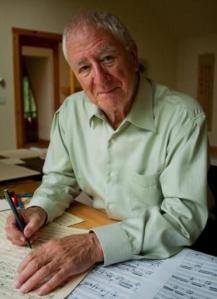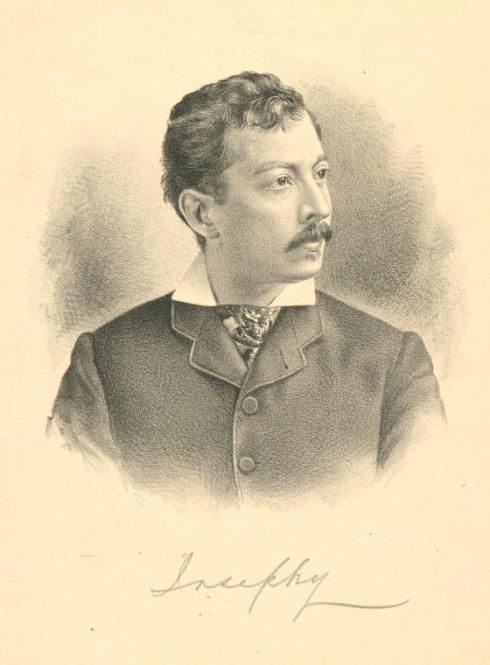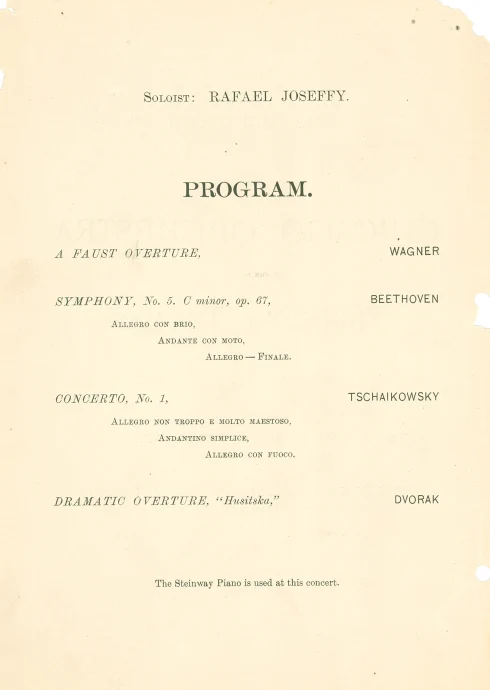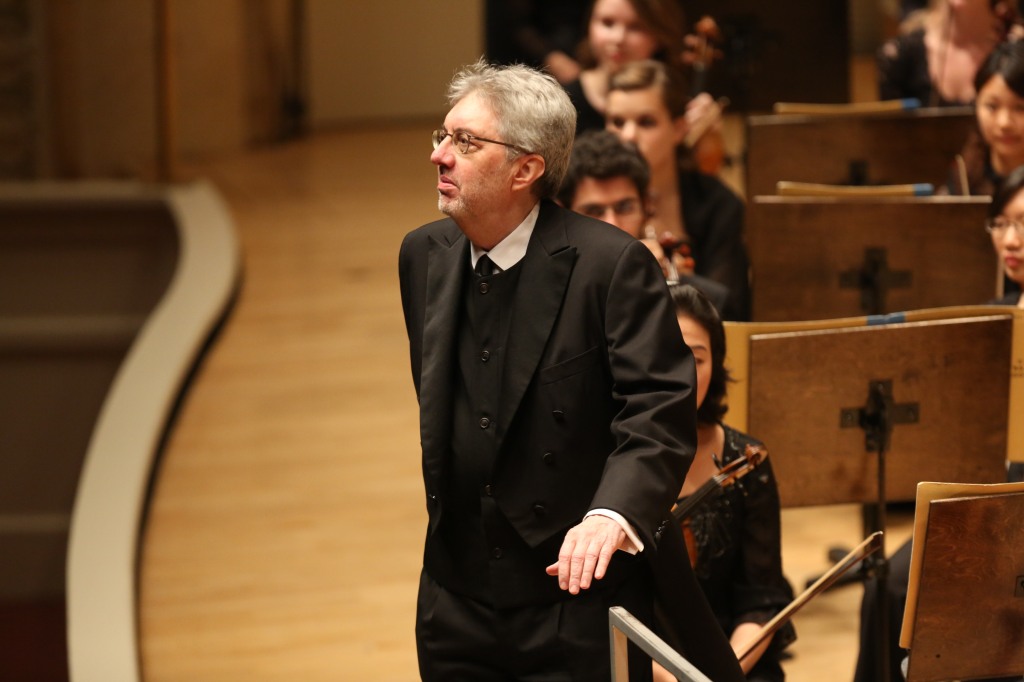You are currently browsing the category archive for the ‘Uncategorized’ category.
The Chicago Symphony Orchestra family joins the music world in mourning the loss of English conductor Sir Andrew Davis, a frequent and beloved guest on the podium for nearly fifty years. He died in Chicago on April 20, 2024, at the age of eighty.
Sir Andrew Davis served as music director and principal conductor of Lyric Opera of Chicago from 2000 until 2021, in addition to holding posts with the BBC Symphony Orchestra, Glyndebourne Festival Orchestra, Melbourne Symphony Orchestra, Toronto Symphony Orchestra, and the Royal Liverpool Philharmonic. Born in 1944 in Hertfordshire, England, Davis studied at King’s College, Cambridge, where he was an organ scholar before studying conducting. In 1992, he was made a Commander of the British Empire, and in 1999 he was designated a Knight Bachelor in the New Year Honors List.
“I first heard Andrew Davis conduct in the fall of 1975 when I was a student at the New England Conservatory. It was a Boston Symphony Orchestra concert, and the main work was Ein Heldenleben, a glorious performance I remember in great detail to this day,” remarked Jeff Alexander, president of the Chicago Symphony Orchestra Association. “I then had the honor of working with him while serving as general manager of the Cincinnati Symphony Orchestra in the 1980s and ’90s, as he often appeared there as guest conductor. Once again, the concerts were beautifully conducted, and getting to know him was a genuine pleasure. How fortunate we have been at the Chicago Symphony Orchestra to have enjoyed Sir Andrew’s music-making, jovial nature, and good wit for nearly fifty years, most recently conducting his orchestration of Handel’s Messiah this past December. The world has lost a great artist, true gentleman, and dear friend. Our memories of his concerts, kind nature, and that ever-present twinkle in his eye will live with us forever.”

“I’m deeply saddened by the news of Andrew’s passing. I’ve known him since my days as the music director of the Philharmonia Orchestra, where he served as my associate conductor,” wrote Riccardo Muti, the CSO’s music director emeritus for life. “Since then, our relationship of friendship and admiration has been long and uninterrupted. My condolences go out to all his family members, to whom I feel close in this sad moment.”
“The news of his passing has come as a shock and is terribly sad,” added Cristina Rocca, vice president of artistic planning for the CSOA. “Sir Andrew was a wonderful, warm, charming person, and a brilliant conductor who served music with such love, passion, knowledge, and commitment! His legacy is huge, and he will be remembered with great fondness and deep respect everywhere. His performances of Messiah, in his own orchestration, back in December, were joyful and marvelous and we were very much looking forward to his return to our stage. He gave so much to music, and we will miss him greatly.”
Davis made his debut with the Chicago Symphony Orchestra in February 1975, leading Elgar’s Introduction and Allegro for Strings, Birtwistle’s The Triumph of Time, and Berlioz’s Harold in Italy with Milton Preves. He first conducted the ensemble at the Ravinia Festival in July 1976, in Lees’s Concerto for String Quartet and Orchestra with the Chicago Symphony String Quartet (Victor Aitay, Edgar Muenzer, Milton Preves, and Frank Miller), Mozart’s Piano Concerto no. 20 with Emanuel Ax, and Beethoven’s Symphony no. 7.
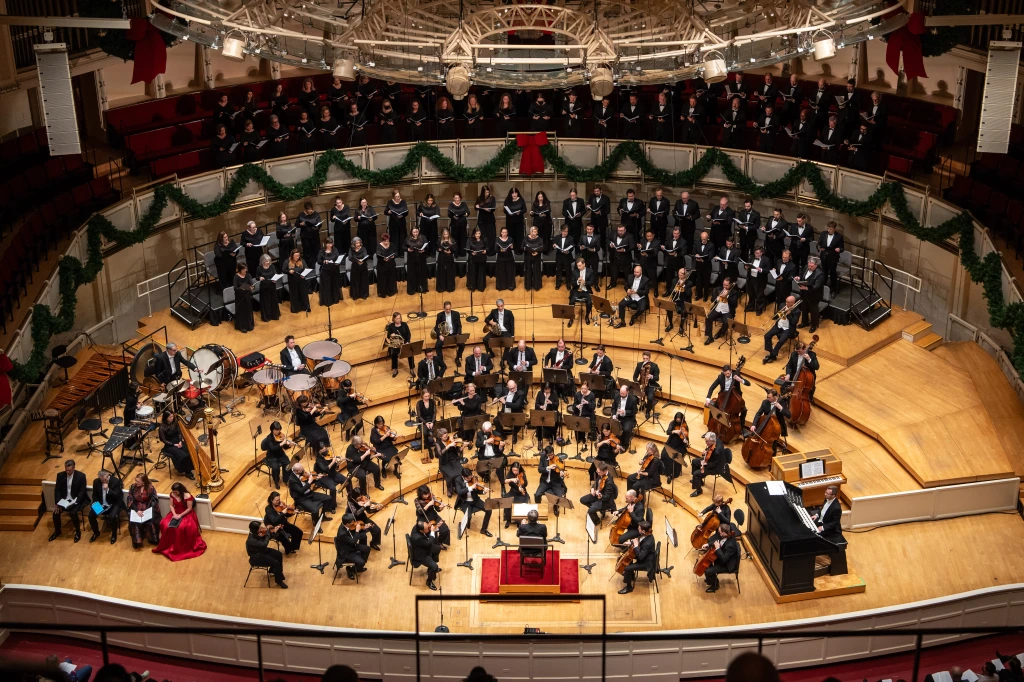
Most recently, Davis led the Orchestra at the Ravinia Festival in July 2016, conducting Vaughan Williams’s Fantasia on a Theme by Thomas Tallis, Elgar’s Cello Concerto with Alisa Weilerstein, and Beethoven’s Symphony no. 5. In December 2023, he was on the podium for the U.S. premiere of his own orchestration of Handel’s Messiah, with the Chicago Symphony Orchestra and Chorus (prepared by James K. Bass) and soloists Joélle Harvey, Jennifer Johnson Cano, Matthew Polenzani, and John Relyea.
A complete list of his performances with the Chicago Symphony Orchestra and Chorus is below.
February 13 and 14, 1975, Orchestra Hall
ELGAR Introduction and Allegro for Strings, Op. 47
BIRTWISTLE The Triumph of Time
BERLIOZ Harold in Italy, Op. 16
Milton Preves, viola
July 29, 1976, Ravinia Festival
LEES Concerto for String Quartet and Orchestra
Chicago Symphony String Quartet
Victor Aitay, violin
Edgar Muenzer, violin
Milton Preves, viola
Frank Miller, cello
MOZART Piano Concerto No. 20 in D Minor, K. 466
Emanuel Ax, piano
BEETHOVEN Symphony No. 7 in A Major, Op. 92
July 31, 1976, Ravinia Festival
BERLIOZ Overture to Beatrice and Benedict
BRAHMS Violin Concerto in D Major, Op. 77
Isaac Stern, violin
ELGAR Variations on an Original Theme, Op. 36 (Enigma)
December 16, 17, and 18, 1976, Orchestra Hall
SUBOTNICK Before the Butterfly
BEETHOVEN Piano Concerto No. 1 in C Major, Op. 15
Stephen Bishop-Kovacevich, piano
DVOŘÁK Symphony No. 7 in D Minor, Op. 70
November 21, 23, and 24, 1979, Orchestra Hall
November 26, 1979, Uihlein Hall, Milwaukee
CHOPIN Piano Concerto No. 1 in E Minor, Op. 11
Jorge Bolet, piano
DVOŘÁK Symphony No. 6 in D Major, Op. 60
June 12, 13, and 14, 1986, Orchestra Hall
BRITTEN Four Sea Interludes from Peter Grimes, Op. 33a
BEETHOVEN Piano Concerto No. 4 in G Major, Op. 58
Mitsuko Uchida, piano
PROKOFIEV Symphony No. 5 in B-flat Major, Op. 100
March 4, 5, 6, and 9, 1999, Orchestra Hall
MOZART Piano Concerto No. 27 in B-flat Major, K. 595
Andreas Haefliger, piano
ELGAR/Payne Symphony No. 3
March 15, 16, and 17, 2001, Orchestra Hall
HAYDN Symphony No. 104 in D Major (London)
BRITTEN Serenade for Tenor, Horn, and Strings, Op. 31
Kurt Streit, tenor
Dale Clevenger, horn
WALKER Lyric for Strings
STRAVINSKY Symphony in Three Movements
July 13, 2001, Ravinia Festival
BRAHMS Violin Concerto in D Major, Op. 77
Sarah Chang, violin
STRAUSS Also sprach Zarathustra, Op. 30
July 14, 2001, Ravinia Festival
BACH/Webern Fuga (Ricercata) a 6 voci from The Musical Offering, BWV 1079
BERG Violin Concerto
Leonidas Kavakos, violin
MENDELSSSOHN Incidental Music to A Midsummer Night’s Dream, Op. 61
John de Lancie, actor
John Mahoney, actor
Janet Zarish, actor
Timothy Gregory, actor
Stacey Tappan, soprano
Lauren McNeese, mezzo-soprano
Chicago Children’s Choir
July 15, 2001, Ravinia Festival
MOZART Piano Concerto No. 12 in A Major, K. 414
Leon Fleisher, piano
MOZART Symphony No. 39 in E-flat Major, K. 543
MOZART Clarinet Concerto in A Major, K. 622
Larry Combs, clarinet
February 6, 7, 8, and 11, 2003, Orchestra Hall
BERLIOZ Overture to Benvenuto Cellini
HINDEMITH Der Schwanendreher
Charles Pikler, viola
DVOŘÁK Symphony No. 6 in D Major, Op. 60
March 19, 2003, Orchestra Hall (MusicNOW)
HOLT Lilith
ANDERSON Alhambra Fantasy
Musicians from the Chicago Symphony Orchestra
June 5, 6, and 7, 2003, Orchestra Hall
HAYDN Symphony No. 92 in G Major (Oxford)
TIPPETT The Rose Lake
BEETHOVEN Symphony No. 8 in F Major, Op. 93
November 8 and 11, 2003, Orchestra Hall
VAUGHAN WILLIAMS Serenade to Music
Samuel Magad, violin
Chicago Symphony Singers
Duain Wolfe, director
TCHAIKOVSKY Romeo and Juliet
January 8, 9, and 10, 2004, Orchestra Hall
JONES at the exactest point (world premiere)
PROKOFIEV Selections from Cinderella, Op. 87
RACHMANINOV Piano Concerto No. 3 in D Minor, Op. 30
Louis Lortie, piano
Stephen Jones’s at the exactest point was released by Tantara Records in 2004
February 10, 2004, Orchestra Hall
BEETHOVEN Symphony No. 9 in D Minor, Op. 125
Deborah Voigt, soprano
Marietta Simpson, mezzo-soprano
Clifton Forbis, tenor
Robert Holl, bass
Chicago Symphony Chorus
Duain Wolfe, director
Davis was a last-minute replacement for Daniel Barenboim, who canceled due to illness.
February 12, 13, and 14, 2004, Orchestra Hall
STRAVINSKY Divertimento, Suite from The Fairy’s Kiss
LIEBERSON Red Garuda for Piano and Orchestra
Peter Serkin, piano
BEETHOVEN Symphony No. 5 in C Minor, Op. 67
September 10, 2004, Orchestra Hall (Opening Night)
TCHAIKOVSKY Violin Concerto in D Major, Op. 35
Nikolaj Znaider, violin
GRIEG Selections from Peer Gynt
Wynton Marsalis, narrator
Valdine Anderson, soprano
Lincoln Center Jazz Orchestra
MARSALIS Expressbrown Local from All Rise
Lincoln Center Jazz Orchestra
Wynton Marsalis, trumpet
September 11, 2004, Orchestra Hall (Marshall Field’s Day of Music)
STRAVINSKY Fireworks
TCHAIKOVSKY Violin Concerto in D Major, Op. 35
Nikolaj Znaider, violin
RAVEL Mother Goose Suite
RAVEL Daphnis and Chloe Suite No. 2
September 12 and 14, 2004, Orchestra Hall
STRAVINSKY Fireworks
SZYMANOWSKI Violin Concerto No. 1, Op. 35
Nikolaj Znaider, violin
RAVEL Mother Goose Suite
RAVEL Daphnis and Chloe Suite No. 2
June 2, 3, and 5, 2005, Orchestra Hall
HANDEL The King Shall Rejoice
HANDEL My Heart is Inditing
HANDEL Zadok the Priest
Chicago Symphony Chorus
Duain Wolfe, director
TIPPETT A Child of Our Time
Nicole Cabell, soprano
Guang Yang, mezzo-soprano
Scott Ramsay, tenor
Christian van Horn, bass-baritone
Chicago Symphony Chorus
Duain Wolfe, director
October 20, 2005, Orchestra Hall
BEETHOVEN Piano Concerto No. 2 in B-flat Major, Op. 19
Evgeny Kissin, piano
BEETHOVEN Piano Concerto No. 1 in C Major, Op. 15
Evgeny Kissin, vgeny; piano
BEETHOVEN Piano Concerto No. 3 in C Minor, Op. 37
Evgeny Kissin, piano
October 22 and 25, 2005, Orchestra Hall
BEETHOVEN Piano Concerto No. 4 in G Major, Op. 58
Evgeny Kissin, piano
BEETHOVEN Piano Concerto No. 5 in E-Flat Major, Op. 73 (Emperor)
Evgeny Kissin, piano
July 30, 2008, Ravinia Festival
BEETHOVEN Fidelio Overture, Op. 72c
BEETHOVEN Piano Concerto No. 5 in E-Flat Major, Op. 73 (Emperor)
Leon Fleisher, piano
BEETHOVEN Symphony No. 3 in E-flat Major, Op. 55 (Eroica)
October 29, 30, and 31, 2009, Orchestra Hall
STRAVINSKY Concerto in E-flat (Dumbarton Oaks)
PRIMOSCH Songs for Adam (world premiere)
Brian Mulligan, baritone
MENDELSSOHN Symphony No. 3 in A Minor, Op. 56 (Scottish)
November 18, 20, 21, and 23, 2010, Orchestra Hall
TURNAGE Texan Tenebrae (U.S. premiere)
BEETHOVEN Piano Concerto No. 4 in G Major, Op. 58
Vladimir Feltsman, piano
VAUGHAN WILLIAMS Symphony No. 9 in E Minor
October 15, 2015, Orchestra Hall
BACH/Davis Passacaglia and Fugue in C Minor, BWV 582
STRAVINSKY Divertimento, Suite from The Fairy’s Kiss
TCHAIKOVSKY Piano Concerto No. 1 in B-flat Minor, Op. 23
Evgeny Kissin, piano
July 16, 2016, Ravinia Festival
VAUGHAN WILLIAMS Fantasia on a Theme by Thomas Tallis
ELGAR Cello Concerto in E Minor, Op. 85
Alisa Weilerstein, cello
BEETHOVEN Symphony No. 5 in C Minor, Op. 67
January 30, January 31, February 1, and 4, 2020, Orchestra Hall
TIPPETT Little Music for String Orchestra
BEETHOVEN Piano Concerto No. 1 in C Major, Op. 15
Paul Lewis, piano
TIPPETT Praeludium for Brass, Bells, and Percussion
BEETHOVEN Piano Concerto No. 4 in G Major, Op. 58
Paul Lewis, piano
December 21, 22, and 23, 2023, Orchestra Hall
HANDEL/Davis Messiah (U.S. premiere)
Joélle Harvey, soprano
Jennifer Johnson Cano, mezzo-soprano
Matthew Polenzani, tenor
John Relyea, bass
Chicago Symphony Chorus
James K. Bass, guest director
Numerous tributes have appeared online, including the BBC, Guardian, Daily Mail, and AP News, among others.
This article also appears here.
The Chicago Orchestra first performed Mendelssohn’s oratorio Elijah on March 13 and 14, 1893, at the Auditorium Theatre in collaboration with the Apollo Musical Club. William L. Tomlins, the Apollo’s long-serving director, was on the podium. “The performance yesterday o’ertopped all previous ones in merit and has place among the finest efforts of the society,” wrote a critic in the Chicago Tribune. “The chorus was present in full working strength, the voices were clear and sure, and leader and singers entered into their work with spirit and confidence, the result being a rendition of the choral portions of the oratorio that was eminently satisfactory.”
The principal soloists on hand were some of the preeminent international singers of the day, including soprano Lillian Nordica, contralto Christine Nielson-Dreier, tenor Italo Campanini, and bass-baritone Plunket Greene.
American Lillian Nordica (1857–1914) was one of the foremost dramatic sopranos of the late nineteenth and early twentieth centuries. Following studies at the New England Conservatory, she established her career in Europe, before making her American opera debut in New York on November 26, 1883 as Marguerite in Gounod’s Faust with Mapleson’s company at the Academy of Music. She performed at Covent Garden and the Bayreuth Festival and was a stalwart with the Metropolitan Opera in New York for nearly two decades. A noted supporter of equal rights for women, Nordica frequently spoke out on the pay disparity between men and women singers. Using her celebrity status, she was a staunch advocate for the women’s suffrage movement, giving concerts, donating funds, and regularly speaking publicly and in the press.
Her performance in Elijah was her debut with the Chicago Orchestra, and she sang “with the dramatic feeling and the brilliancy it demands.” Nordica later appeared with the Orchestra on numerous occasions, on subscription concerts at the Auditorium Theatre, at the World’s Columbian Exposition, and as a leading artist with the Metropolitan Opera on tour.
Originally from Madison, Wisconsin, contralto Christine Nielson-Dreier (1866–1926) gained initial acclaim during her first tour of Europe in 1889, especially at the Palais du Trocadéro during the Exposition Universelle in Paris. The following year, she performed at the concert dedicating the grand organ at the Auditorium Theatre. During the first week of the Chicago Orchestra’s inaugural season, she was soloist with the ensemble and Theodore Thomas on the first run-out concert to to Rockford, Illinois, on October 18, 1891. Nielson-Dreier later appeared with the Orchestra at the World’s Columbian Exposition and on subscription concerts at the Auditorium, and she also was soloist at Fourth Presbyterian Church for many years. In Elijah, her performance was noted as a “pleasant feature of the evening. She sings with taste, intelligence, and skill,” delivering her “finest work” in the aria “O Rest in the Lord.”

Italian tenor Italo Campanini (1845–1896) established his career primarily in London before becoming the first leading tenor at the Metropolitan Opera. He inaugurated the company’s new house on October 22, 1883, in the title role in Gounod’s Faust with Christine Nilsson (not to be confused with Christine Nielson-Dreier) as Marguerite. Campanini had previously appeared with the Chicago Orchestra on subscription concerts as well as the ensemble’s first performances of Berlioz’s Damnation of Faust during the inaugural season.
(Italo’s brother and conductor Cleofante Campanini made his debut in this country in New York in 1888, leading the U.S. premiere performances of Verdi’s Otello, with his brother later taking over the title role. In Milan, he was conductor for the premieres of Cilea’s Adriana Lecouvreur at the Teatro Lirico in 1902 and Puccini’s Madama Butterfly at La Scala in 1904. In 1909, he was appointed music director of the Chicago Grand Opera Company, the city’s first resident opera company.)
Campanini must have been under the weather during the run of Elijah in 1893. Charles A. Knorr (1852–1937) performed the tenor solos on March 13, and the Chicago Tribune review for the second performance reported “the indulgence of the audience was asked for Sig. Campanini. The music of the part of Obadiah he sang carefully and with fairly good success.”
The debut of Irish bass-baritone Plunket Greene (1865–1936), during this, his first tour of the United States, was one of the most anticipated events of the season. Singing the title role in these performances of Elijah, he possessed “rare qualities of a beautiful voice, artistic taste, thorough musicianship, and strong, emotional power . . . He is an artist in the best sense of the word, and his singing of the music of Elijah last night gave thorough, keen delight, and satisfaction. . . . Anything more beautiful in vocal finish or more touching in expressiveness than the latter noble air as sung by Mr. Greene has rarely been heard in this city.”
Greene continued to appear with the Orchestra, on subscription concerts at the Auditorium Theatre, at the World’s Columbian Exposition, and on tour at the Cincinnati May Festival. A close friend of Sir Edward Elgar, Greene was a soloist in the world premiere of The Dream of Gerontius in October 1900, was the dedicatee of Ralph Vaughan Williams’s Songs of Travel, and in 1892 created the title role in the premiere of Sir Hubert Parry’s Job (later marrying the composer’s daughter). He authored Interpretation in Song, a valuable instruction book for singers; a biography of composer Charles Villiers Stanford; and Where the Bright Waters Meet, a testament to his love of fly fishing.
This article also appears here.
The Chicago Symphony Orchestra family mourns the loss of legendary American pianist Byron Janis. He died in Manhattan on March 14, 2024, at the age of ninety-five.
Janis made his professional debut at the age of fifteen in 1943, performing Rachmaninov’s Second Piano Concerto with the NBC Symphony Orchestra, under the baton of Frank Black. The following year, he was chosen by Vladimir Horowitz as his first student, and at eighteen, he became the youngest artist signed to a contract by RCA Victor Records. On October 29, 1948, Janis made his Carnegie Hall debut, and Olin Downes in the New York Times wrote, “Not for a long time had this writer heard such a talent allied with the musicianship, the feeling, the intelligence and artistic balance shown by the twenty-year-old pianist, Byron Janis. . . . Whatever he touched he made significant and fascinating by the most legitimate and expressive means.”
On March 4, 1954, Janis made his debut with the Chicago Symphony in Orchestra Hall. “Mr. Janis played a performance of the Tchaikovsky concerto uncommonly beautiful for what it was, and uncommonly exciting for what it can be. . . . If you have it, you have it, and Mr. Janis does,” wrote Claudia Cassidy in the Chicago Tribune. “He has temperament and fire and he wants, perhaps more than anything in the world, to play the piano. You can always tell that by the sound. It comes out in the explosions of the double octaves, in the instinctive sensing of the crest of a phrase . . . his Tchaikovsky was big, beautiful and dynamic, yet with all its tensions it sensed the relaxed sweep of the grand style. . . . Reiner and the Orchestra gave superb collaboration, part Russian song, part Russian bear.”
For more than twenty years, Byron Janis was a regular visitor, as soloist with the Chicago Symphony Orchestra and as a recitalist in Orchestra Hall. A complete list of his appearances is below.
July 10, 1952, Ravinia Festival
BEETHOVEN Piano Concerto No. 3 in C Minor, Op. 37
Dimitri Mitropoulos, conductor
March 4 and 5, 1954, Orchestra Hall
TCHAIKOVSKY Piano Concerto in B-flat Minor, Op. 23
Fritz Reiner, conductor
July 27, 1956, Ravinia Festival
BERNSTEIN Symphony No. 2 (The Age of Anxiety)
Leonard Bernstein, conductor
December 6 and 7, 1956, Civic Opera House
RACHMANINOV Piano Concerto No. 1 in F-sharp Minor, Op. 1
STRAUSS Burlesque for Piano and Orchestra in D Minor
Fritz Reiner, conductor
August 2, 1957, Ravinia Festival
RACHMANINOV Piano Concerto No. 3 in D Minor, Op. 30
William Steinberg, conductor
August 3, 1957, Ravinia Festival
TCHAIKOVSKY Piano Concerto No. 1 in B-flat Minor, Op. 23
William Steinberg, conductor
January 20, 1958, Pabst Theatre, Milwaukee
BEETHOVEN Piano Concerto No. 3 in C Minor, Op. 37
Carlo Maria Giulini, conductor
July 17, 1958, Ravinia Festival
RACHMANINOV Piano Concerto No. 1 in F-sharp Minor, Op. 1
Walter Hendl, conductor
July 22, 1958, Ravinia Festival
BEETHOVEN Piano Concerto No. 3 in C Minor, Op. 37
Igor Markevitch, conductor
February 19 and 20, 1959, Orchestra Hall
SCHUMANN Piano Concerto in A Minor, Op. 54
Fritz Reiner, conductor
February 24, 1959, Orchestra Hall
LISZT Totentanz for Piano and Orchestra
Fritz Reiner, conductor
March 23, 1959, Pabst Theatre, Milwaukee
SCHUMANN Piano Concerto in A Minor, Op. 54
Fritz Reiner, conductor
July 9, 1959, Ravinia Festival
TCHAIKOVSKY Piano Concerto No. 1 in B-flat Minor, Op. 23
Walter Hendl, conductor
July 11, 1959, Ravinia Festival
RACHMANINOV Piano Concerto No. 3 in D Minor, Op. 30
Walter Hendl, conductor
February 4 and 5, 1960, Orchestra Hall
LISZT Piano Concerto No. 1 in E-flat Major
Fritz Reiner, conductor
February 9, 1960, Orchestra Hall
LISZT Concerto for Piano No. 2 in A Major
Fritz Reiner, conductor
July 5, 1960, Ravinia Festival
RACHMANINOV Piano Concerto No. 2 in C Minor, Op. 18
Walter Hendl, conductor
July 7, 1960, Ravinia Festival
SCHUMANN Piano Concerto in A Minor, Op. 54
Walter Hendl, conductor
July 20, 1961, Ravinia Festival
RACHMANINOV Piano Concerto No. 1 in F-sharp Minor, Op. 1
Joseph Rosenstock, conductor
July 22, 1961, Ravinia Festival
LISZT Piano Concerto No. 1 in E-flat Major
Joseph Rosenstock, conductor
January 4 and 5, 1962, Orchestra Hall
TCHAIKOVSKY Piano Concerto No. 1 in B-flat Minor, Op. 23
Leopold Stokowski, conductor
August 4, 1962, Ravinia Festival
LISZT Concerto for Piano No. 2 in A Major
RACHMANINOV Rhapsody on a Theme of Paganini, Op. 43
André Cluytens, conductor
November 1, 2, and 3, 1962, Orchestra Hall
November 4, 1962, Edgewater Beach Hotel (WGN Great Music from Chicago television broadcast)
November 5, 1962, Pabst Theatre, Milwaukee
PROKOFIEV Piano Concerto No. 3 in C Major, Op. 26
Hans Rosbaud, conductor
July 11, 1963, Ravinia Festival
RACHMANINOV Piano Concerto No. 3 in D Minor, Op. 30
Walter Hendl, conductor
July 16, 1963, Ravinia Festival
GRIEG Piano Concerto in A Minor, Op. 16
Seiji Ozawa, conductor
November 21 and 22, 1963, Orchestra Hall
RACHMANINOV Piano Concerto No. 2 in C Minor, Op. 18
Jean Martinon, conductor
December 31, 1964, January 1 and 2, 1965, Orchestra Hall
January 4, 1965, Pabst Theatre, Milwaukee
MOZART Piano Concerto No. 23 in A Major, K. 488
Willem van Otterloo, conductor
July 26, 1966, Ravinia Festival
RACHMANINOV Piano Concerto No. 1 in F-sharp Minor, Op. 1
RACHMANINOV Piano Concerto No. 2 in C Minor, Op. 18
Seiji Ozawa, conductor
July 28, 1966, Ravinia Festival
RACHMANINOV Piano Concerto No. 3 in D Minor, Op. 30
RACHMANINOV Rhapsody on a Theme of Paganini, Op. 43
Seiji Ozawa, conductor
April 20 and 21, 1967, Orchestra Hall
PROKOFIEV Piano Concerto No. 1 in D-flat Major, Op. 10
STRAUSS Burlesque for Piano and Orchestra in D Minor
Irwin Hoffman, conductor
June 27, 1967, Ravinia Festival
PROKOFIEV Piano Concerto No. 3 in C Major, Op. 26
Seiji Ozawa, conductor
June 29, 1967, Ravinia Festival
GERSHWIN Concerto in F for Piano and Orchestra
Seiji Ozawa, conductor
June 29, 1968, Ravinia Festival
BEETHOVEN Piano Concerto No. 3 in C Minor, Op. 37
Seiji Ozawa, conductor
July 6, 1971, Ravinia Festival
STRAUSS Burlesque for Piano and Orchestra in D Minor
LISZT Piano Concerto No. 1 in E-flat Major
Lawrence Foster, conductor
June 29, 1973, Ravinia Festival
PROKOFIEV Piano Concerto No. 3 in C Major, Op. 26
James Levine, conductor
August 15, 1974, Ravinia Festival
SAINT-SAËNS Piano Concerto No. 5 in F Major, Op. 103 (Egyptian)
David Zinman, conductor
Janis also made several recordings with the Chicago Symphony Orchestra, as follows:
LISZT Totentanz for Piano and Orchestra
Fritz Reiner, conductor
Recorded in Orchestra Hall on February 23, 1959, for RCA
RACHMANINOV Piano Concerto No. 1 in F-sharp Minor, Op. 1
Fritz Reiner, conductor
Recorded in Orchestra Hall on March 2, 1957, for RCA
SCHUMANN Piano Concerto in A Minor, Op. 54
Fritz Reiner, conductor
Recorded in Orchestra Hall on February 21, 1959, for RCA
STRAUSS Burlesque for Piano and Orchestra in D Minor
Fritz Reiner, conductor
Recorded in Orchestra Hall on March 4, 1957, for RCA
Under the auspices of Allied Arts, Janis has appeared as piano recitalist on several occasions, as follows:
March 25, 1956
March 15, 1958
April 9, 1961
April 29, 1962
January 16, 1966
January 29, 1967
December 1, 1968
May 5, 1974
December 16, 1975
February 8, 1976
Numerous tributes have been posted online, including the New York Times, AP News, and the Hollywood Reporter, among several others.
This article also appears here.

The advance notice for the November 9, 1891, performance of Lohengrin included the names of producers, principal singers, conductor, and stage manager, but not the accompanying orchestra.
Following the third subscription week of its first season, the Chicago Orchestra was in the pit of the Auditorium Theatre for performances by the Metropolitan Opera Company from November 9 until December 12, 1891, including three run-out performances at the Amphitheatre Auditorium in Louisville, Kentucky, on December 7 and 8.
The first opera given was Wagner’s Lohengrin—sung in Italian—led by Auguste Vianesi, the Orchestra’s first guest conductor. That performance featured no less than five singers making their U.S. debuts: soprano Emma Eames, mezzo-soprano Giulia Ravogli, baritone Antonio Magini-Coletti, and tenor and bass brothers Jean and Édouard de Reszke.
On November 10, 1891, the Chicago Daily Tribune reported that even though several patrons were late in arriving due to “the fact that carriages approached in single file and the process of unloading was rather slow . . . [they] failed to dismay Sig. Vianesi, who began his calisthenic exercise with the baton promptly at eight. Eighty-five musicians of the Chicago Orchestra played the graceful Lohengrin prelude in a style which in the show-bill style was ‘alone worth the price of admission.’”
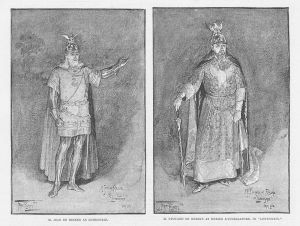
Wood engraved print by Fred Pegram of Jean and Edouard de Reszke—as Lohengrin and Heinrich—from The Illustrated London News in 1891
In the title role, Jean de Reszke “has the dignity and aplomb of an artist to the manner born and the glittering armor of the Knight of the Grail becomes him well. . . . [He] is an artist to the tips of his mailed boots and gloves. He has immense personal magnetism, and when he casually conveyed to Elsa the information, ‘Io t’amo,’ there was a responsive thrill under many a pretty corsage bouquet.”
“Her voice is one of beauty, and she uses it in a manner that shows great care and study in the training of it,” continued the reviewer in describing Emma Eames. “Here is a classic beauty, and a more charming picture than she presented when clothed in the wedding robes of Elsa has rarely been seen upon any stage.”
On November 14, the New York Times reported from Chicago. “It was though reason for not a little regret both in New York and this city when it was announced that the management of the Metropolitan Opera House, which in a measure seems to control the operatic destiny of the country, had decided to discontinue German opera this year and to substitute therefore Italian opera. By selecting Lohengrin as the opera with which to open the present season, Messrs. Abbey and Grau made a praiseworthy compromise. All fears that the season would be composed of a series of repetitious of hackneyed Italian operas were thus allayed. It is too early to pass any judgment, but, according to the indications to be found in this week’s performances, it is almost safe to assume that in many respects this year will witness some of the most brilliant performances of grand opera ever given in this country.”
Regarding Édouard de Reszke as Heinrich, the Times continued, that he was “endowed with a voice which for power and quality, richness and warmth, range and volume, has seldom been equaled. He displayed the highest art in the use of it. His acting also was artistic, and dignified, and his impersonation was in every respect a regal one.” As Ortrud, Giulia Ravogli, “displayed histrionic ability of an exceptionally high order and a mezzo-soprano voice of extensive compass and considerable power.”
Additional singers who appeared during the residency were among the most famous of the day, including sopranos Emma Albani, Lilli Lehmann and Marie Van Zandt; mezzo-soprano Sofia Scalchi; tenor Fernando Valero; baritones Edoardo Camera and Jean Martapoura; and bass Jules Vinché. A staggering number of operas were performed, including Bellini’s Norma and La sonnambula; Flotow’s Martha; Gluck’s Orpheus and Eurydice; Gounod’s Faust and Romeo and Juliet; Mascagni’s Cavalleria rusticana; Meyerbeer’s Dinorah and Les Huguenots; Mozart’s Don Giovanni; Thomas’s Mignon; and Verdi’s Aida, Otello and Rigoletto.
The final offering of the month-long residency on December 12 was a fourth performance of Lohengrin, and changes in the cast included Valero in the title role, Albani as Elsa, and Vinché as Heinrich; Louis Saar conducted. Two days later on December 14, the company was back in New York for the Metropolitan Opera’s season opening: Gounod’s Romeo and Juliet featuring Eames and the de Reske brothers with Vianesi on the podium.
After two run-out performances on December 15 (at the Odeon in Cincinnati) and 16 (in Indianapolis), founder and first music director Theodore Thomas and his Chicago Orchestra resumed the regular season with the fourth subscription week at the Auditorium on December 18.
Susanna Mälkki leads the Chicago Symphony Orchestra in Wagner’s Prelude to Lohengrin on March 21, 23, and 24, 2024.
This article also appears here, and an abbreviated version appears in the program book.
For the Chicago Orchestra’s inaugural concerts on October 16 and 17, 1891, founder and first music director Theodore Thomas led Wagner’s A Faust Overture, Beethoven’s Fifth Symphony, Dvořak’s Husitská Overture, and Tchaikovsky’s First Piano Concerto, featuring Rafael Joseffy (1852–1915).
Following the first Friday afternoon matinee, the reviewer in the Chicago Tribune noticed that Joseffy “brought no raiment from New York but an evening suit and a light gray make-up for the street, so he committed the glaring faux pas of appearing in a swallow-tail, vest, etc., before six o’clock in the afternoon. [This] was a matter of little importance, however, after he began to play. . . . Joseffy was distinctly the feature of the concert, and he was recalled three times.”
“Rafael Joseffy was the master who touched the keys and an orchestra able to reveal the beauties of the difficult score gave support,” continued the reviewer after the Saturday evening performance. “His mastery of every detail of the technique of his art was displayed in the first and the last movements of the work; in the climax of the latter his rapidity and ease of chord and octave playing being especially excellent. The middle division of the great composition he read with more poetry and feeling than have been revealed by him at any previous appearance in this city.”
A native of Hungary, Rafael Joseffy studied with Carl Tausig at the Berlin Conservatory and Franz Liszt in Weimar before moving to New York in early 1879. He made his U.S. debut on October 13 in Chickering Hall in New York City under Leopold Damrosch, performing the first piano concertos of Chopin and Liszt.
Joseffy toured soon thereafter and appeared in Boston on November 6, again in Chopin’s E minor concerto. “His pianissimo is something absolutely wonderful with its delicacy, purity of tone, and sweetness,” wrote a reviewer for the Musical Review. “It is difficult to imagine the composer himself imparting a more perfect elegance.” Three days later, Joseffy made his Chicago debut, giving a recital at McCormick Hall on November 9, 1879.
With Thomas, Joseffy made his New York Philharmonic debut on February 21, 1880, performing Chopin’s Second Piano Concerto at the Academy of Music. Over the next decade, the two collaborated on numerous occasions, both with the philharmonic and the Theodore Thomas Orchestra, Thomas’s traveling ensemble.
With a strong affinity for teaching, Joseffy was head of the piano faculty at the National Conservatory of Music of America in New York City between 1888 and 1906, where his colleagues included Antonín Dvořák and Victor Herbert.
Joseffy appeared in Chicago only once more, in March 1895, and was warmly received, “[proving] his absence had served to increase rather than diminish his hold on the public,” according to the Chicago Tribune. He performed Brahms’s Second Piano Concerto with the Chicago Orchestra and Thomas, and “the sympathy between pianist, conductor, and orchestra . . . was notable [and] the poetry which marks the andante was reflected in admirable spirit, and the allegro, in delicacy, taste, and polish, proved perfection.”
Soon thereafter, Joseffy shied away from concertizing and touring and devoted his time to composing, teaching, and writing. For G. Schirmer, he was the editor of multivolume editions of works by Chopin and Liszt and author of School of Advanced Piano Playing, a book of etudes that includes the entire range of piano technique. He never made any recordings.
“A cool, silvery touch of penetrating sweetness was Joseffy’s, a comminglement of magic and moonlight,” wrote James Huneker in Joseffy’s New York Times obituary. “No pianist, with the exception of Chopin, has paralleled his mastery of the nuance.”
This article also appears in the program book for the February 23, 24, and 27, 2024, concerts and here.

